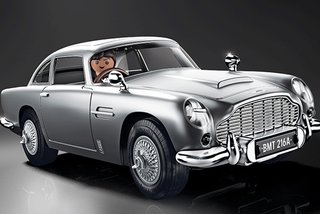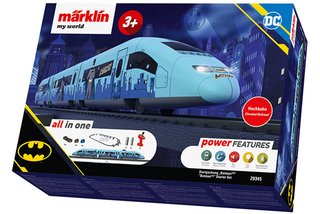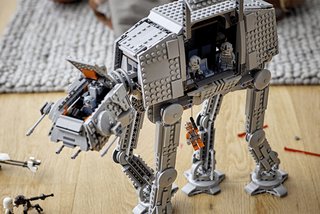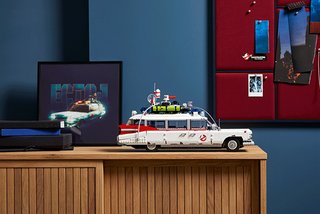
With the license to play
Toys from the world of films and TV
By Peter Thomas
Toys from the world of films and TV Toy licenses from movie theatre and TV productions are especially successful. Products that implement the technical functions of their media archetype into the model are particularly well-received. This tradition is now almost 60 years old.

An ejection seat, an extendable shield in the rear and more: All of these features make this golden sportscar from 1965 a bestseller. Its driver’s name? Bond, James Bond! In cooperation with the film’s producers, British manufacturer Corgi introduced the world’s best-known secret agent’s Aston Martin DB5 to the market just in time before the release of the fourth Bond movie, “Thunderball”.The licensed functional model was designed in the style of its counterpart from the 1964 blockbuster “Goldfinger” and realised a realignment of James Bond merchandising towards a younger target group. The decision had a clear effect: Children and teenagers enjoyed the miniature’s play functions just as much as Sean Connery playing James Bond enjoyed the gadgets built into his car by Q. The model by Corgi turned out to be a great success, received awards left and right, such as the “Best Boys Toy” award in 1965 – and paved the way for the fruitful exchange between the worlds of films and toys.
Almost 60 years after the premiere of “Goldfinger”, the legendary film car’s radiant power is unbroken – around the entire globe. This is shown by, for example, Playmobil’s edition of the “Goldfinger” Aston Martin DB5. The German manufacturer’s designers put a lot of effort into the various functions of the miniature, says Playmobil spokesperson Björn Seeger: “The attention to detail and its nifty play functions were a challenge”. The effort definitely paid off and the car turned out to be a true cult classic. Playmobil turned to its own development department for the technical developments: “In doing so, we delve deeply into the models and special features”. The goal is clear: “What we want to achieve is for Playmobil models such as the Aston Martin to be undoubtedly based on the original, while at the same time offering a high play value”.

Turning fascinating models from films into toys with technical functions has an especially long tradition in the area of construction toys and model construction. But also related sectors such as model railways benefit from being combined with cinematic material. Märklin, for instance, released a “Batman” starter pack for its beginner’s series my world. “Children between the ages of three and six love to dive into the world of superheroes”, says Jörg Iske, head of marketing at Märklin. And that perfectly suits the target group of my world.
Märklin entered into the film and TV licensing business with an edition to “Jim Button and Luke the Engine Driver”. The traditional German manufacturer’s experiences with these products were very good, as Iske sums it up: “The theme was generally regarded favourably and the train in the story led to a very natural connection to Märklin. The successful films and all the media attention coupled with our licensed products, especially the locomotive Emma, positively charged the brand and brought Märklin into many children’s rooms.” But also adult fans of the story were thereby inspired to try out model railways. “That fits well with our motto: Märklin brings generations together”, Iske laughs.

Playmobil and Märklin join an international success story with these positive experiences. This is because licensed toys with which scenes from popular movies and series can be re-enacted have been booming for years. The “Star Wars” sets by Lego, for example, turned out to be true bestsellers. Spanning various scales and technical approaches, a whole separate world made out of the building bricks all around the saga of Luke Skywalker and co developed over time.

One of the more recent film adaptions in the world of Lego is the set inspired by the “Back to the Future” trilogy: The iconic DeLorean sportscar can be built as desired – in all of its three movie variants. The set is targeted towards adults who grew up watching the classic films and use the rolling time machine for their own little journey through time back into childhood.
With its licensed Star Wars building kits, Lego was a pioneer as of 1999. The Horst Brandstätter Group, which is behind the Playmobil brand, commenced licensing co-operations with film and TV for its toy world in 2017. The successful start, says the Playmobil spokesperson, was marked by “Ghostbusters” five years ago. The next big thing fans can look forward to are 24 characters out of the anime series “Naruto Shippuden” coming out in October 2022.
But also customers provide inspirations for new licenses, according to Seeger: “We receive numerous little letters from small and big Playmobil fans with wishes for new themes. These are also impacted by blockbusters, current TV series and trends”. Märklin also strives to further develop its licensed products: “We are currently in discussions for various licenses, as we are convinced by the positive effect licensed themes have on the toy sector”, says Jörg Iske. The Märklin expert nonetheless emphasis: “The themes have to fit to the brand and target group, though”. Customers also value attention to detail. That is why Playmobil went for a silver paint job for their realisation of the British agent’s Aston Martin – instead of a golden one like Corgi did in the 1960s.
About the Author:
Telling stories about technology and people: This has fascinated the journalist, author, cultural scientist and lecturer for more than 30 years. Technical toys are always in focus, from construction kits to interactive digital learning toys. After studying and working as a research assistant at the university, Peter Thomas writes for daily newspapers, magazines and company publications in German and English-speaking markets. In addition to the world of toys, his main areas of focus are mobility, security, safety and medical technology.

